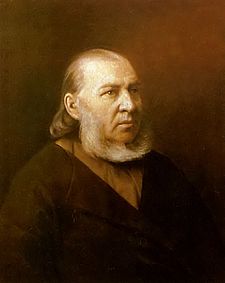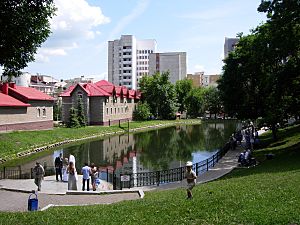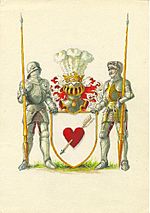Sergey Aksakov facts for kids
Quick facts for kids
Sergey Aksakov
|
|
|---|---|

Portrait of Aksakov by Vasily Perov
|
|
| Born | October 1, 1791 Ufa, Ufa Governorate, Russian Empire |
| Died | May 12, 1859 (aged 67) Moscow, Russian Empire |
| Period | 1810s-1850s |
| Children | Ivan Aksakov Konstantin Aksakov Vera Aksakova |
| Relatives | Alexandr Aksakov |
Sergey Timofeyevich Aksakov (born October 1, 1791 – died May 12, 1859) was a famous Russian writer from the 1800s. He is best known for his stories about family life, which were often based on his own experiences. He also wrote popular books about his favorite hobbies: hunting and fishing.
A crater on the planet Mercury is named Aksakov in his honor. This shows how important he was!
Contents
Early Life and Education
Sergey Aksakov was born in Ufa, a city in what was then the Russian Empire. He grew up there and at his family's country home in Novo-Aksakovka. Living in the countryside helped him develop a deep love for nature, which later became a big part of his writing.
His mother introduced him to books at a young age. He especially enjoyed long poems and plays that were popular at the time.
Aksakov went to school at the Kazan Gymnasium. Later, in 1805, he attended Kazan University during its first year. However, he felt he wasn't ready for university studies. Some of his professors taught in foreign languages, which made it even harder. He was also very interested in the theater, which sometimes distracted him from his studies.
Starting His Career
In 1807, Aksakov left the university. The next year, he moved to St. Petersburg to work for the government. He found he wasn't very prepared for this job either. Again, he spent a lot of time enjoying the theater.
He met Alexander Shishkov, a well-known conservative figure who preferred traditional Russian literature. This meeting helped Aksakov appreciate classic Russian writings even more. In 1811, he quit his government job and moved to Moscow. There, he became active in the city's literary and theater scene. He even published his first poem anonymously in 1812.
Aksakov joined the militia and took part in the war against Napoleon in 1812. After the war, he decided to live a quieter life as a country gentleman. He settled at his estate in Aksakovo, where he lived from 1816 to 1826. After that, he mostly lived in Moscow.
In 1816, he married Olga Semenovna Zaplatina. They had many children together, including six sons and eight daughters. His oldest daughter, Vera Aksakova, born in 1819, also became a writer.
Literary Achievements
Aksakov started publishing translations, reviews, and articles in the early 1820s. However, his most important works came much later. In 1827, he joined the Moscow Censorship Committee, which decided what books could be published. He was dismissed in 1832 for allowing a pamphlet about drunken policemen to be published.
In 1833, he became an inspector at a surveying school. In 1835, he became the first director of the Constantine Geodetic Institute. He retired from government service in 1838.
In 1832, Aksakov met the famous writer Nikolai Gogol. Aksakov felt that Gogol had a truly Russian genius, unlike any other writer he had met. Aksakov's home in Moscow became a gathering place for those who admired Gogol's work. Gogol encouraged Aksakov to write stories based directly on real life, rather than trying to fit them into old-fashioned styles.
In 1834, Aksakov published his first realistic story, "A Blizzard." Around 1840, with Gogol's encouragement, he began writing the book that would make him famous: A Family Chronicle. While working on it, he also published books about his favorite hobbies: Notes on Fishing (1847) and Notes of a Hunter in Orenburg Province (1852). These books were praised for their clear writing style and detailed descriptions. Other famous writers, like Ivan Turgenev, loved them. Gogol even told Aksakov that his "birds and fishes are more alive than my men and women."
Later Life and Legacy

In 1843, Aksakov settled in the village of Abramtsevo, near Moscow. This home became a popular spot for other writers, including Gogol, Turgenev, and Tolstoy. His sons, Konstantin and Ivan, who were also writers, often visited.
In the late 1850s, Aksakov published his most lasting works: The Family Chronicle (1856) and Childhood Years of Bagrov Grandson (1858). These books were based on his own childhood memories of growing up in a traditional Russian family. They earned him recognition as a top-tier literary artist. Aksakov's stories are known for their careful and detailed descriptions of the daily life of Russian noble families.
Among Aksakov's other works are The History of My Acquaintance with Gogol and Memoirs. He also wrote a fairy tale called The Scarlet Flower, which was made into an animated movie in the Soviet Union in 1952.
Family
Sergey Aksakov married Olga Semyonovna Zaplatina. Her father was a general, and her mother was a Turkish woman. Sergey and Olga had four sons: Konstantin, Gregory, Ivan, and Mikhail. They also had seven daughters: Vera, Olga, Nadezhda, Anna, Lyubov, Maria, and Sophia.
English Translations
Many of Aksakov's works have been translated into English, allowing readers around the world to enjoy his stories. Some of these include:
- A Russian Schoolboy (1917)
- A Russian Gentleman (1917)
- The Family Chronicle (1961)
- Notes on Fishing (1997)
- Notes of a Provincial Wildfowler (1998)
See also
 In Spanish: Serguéi Aksákov para niños
In Spanish: Serguéi Aksákov para niños


